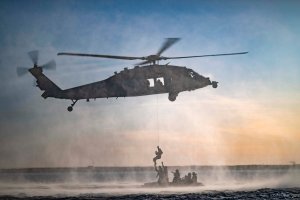

More than half of the California National Guard’s specialized firefighting teams are deployed to Los Angeles County as part of the federal mission in the area, leaving the guard at only 40% of its firefighting operation capacity.
Eight of the guard’s 14 firefighting teams — operating under Task Force Rattlesnake — are among the more than 4,000 California National Guard troops currently under federal command, California Gov. Gavin Newsom announced, as the state is well within its dangerous fire season.
The California Military Department, which oversees the California National Guard, confirmed Newsom’s claims. Carl Trujillo, a spokesperson for the department, said that the move to federalize National Guard soldiers “impacted Task Force Rattlesnake teams from every region of the state.” That task force, comprising 300 California Air and Army National Guard troops, works with the state’s Department of Forestry and Fire Protection, or Cal Fire. Now only six crews are currently left to help wider state firefighting efforts.
“With peak fire season well underway across California, we need all available resources to protect communities,” Newsom said in a statement on June 24. “President Trump: rescind your illegal order and get the Guard back to the critical firefighting and prevention work that actually keeps communities safe.”
The military firefighting teams join state civilian and local firefighters fighting large wildfires and smaller blazes before they can spread. The task force was created in 2019 to deal with the rising frequency of large and destructive blazes in the state. Initially comprising only 100 National Guard troops, it has tripled in size since.
Newsom had pointed out staffing shortfalls for Task Force Rattlesnake on June 18, but this past week he noted it had gotten worse, reaching a 60% reduction. The shortage comes as California is in its fire season, which lasts from late spring into fall, when high temperatures and dry conditions put the state most at risk of destructive wildfires.
The troops that make up Task Force Rattlesnake are “Type 1” hand crews, which are teams with more extensive training and qualifications than firefighting teams brought in for initial responses, according to the U.S. Forest Service. Cal Fire Battalion Chief David Acuña told Task & Purpose that those Task Force Rattlesnake teams are “an excellent resource,” with both strong abilities and clear chains of command. Each team, he said, includes 12 members from the California Military Department and two Cal Fire members.
One major issue with the firefighting teams going under federal control is that there isn’t a way to recall them back to the state for wildfire fighting duty, Trujillo said.
“Once federalized, they fall under federal command and cannot be re-tasked by the state — even in the event of a major wildfire,” Trujillo said in a statement to Task & Purpose.
Task Force Rattlesnake teams took part in fighting the series of deadly wildfires that tore through Los Angeles County in January. In fact, several of the National Guard members deployed to the Los Angeles area were also activated during the response to the Eaton and Palisades fires, according to the National Guard itself. It’s unclear how many of the approximately 4,100 National Guard troops in Task Force 51 were in Los Angeles in January as part of Task Force Rattlesnake or with the military police units brought in to aid local law enforcement.
National Guard troops with the 79th Infantry Brigade Combat Team and the 49th Military Police Brigade were brought under federal command earlier this month, in response to protests against immigration raids in Los Angeles. U.S. Northern Command, which organized them as well as 700 Marines from 2nd Battalion, 7th Marine Regiment under Task Force 51. Their mission is to protect federal personnel and property.
A NORTHCOM spokesperson told Task & Purpose last week that although protests in Los Angeles were the “catalyst” for the federalization of troops, “NORTHCOM’s mission is not constrained by the geography of Southern California.” Trump’s original June 7 order did not specify a specific location or even mention Los Angeles or the state of California. The state of California is currently suing the federal government to retake control of the federalized troops; that case is ongoing.
So far this fire season, there has not been a massive blaze akin to the devastating Eaton and Palisades fires, Acuña said. However Cal Fire teams have been busy dealing with smaller fires around the state, working to prevent them from growing into massive wildfires. Crews are available to respond throughout the state and go where needed, he said.
The latest on Task & Purpose
- An Army base will now honor a Buffalo Soldier
- 2 aircraft carriers, 9 destroyers, and multiple fighter wings gather in the Middle East
- Marines and sailors are building trenches for the drone age
- The Army is deactivating police units in deep cuts to number of military cops
- Military intelligence battalion sergeant major arrested for DUI and suspended
